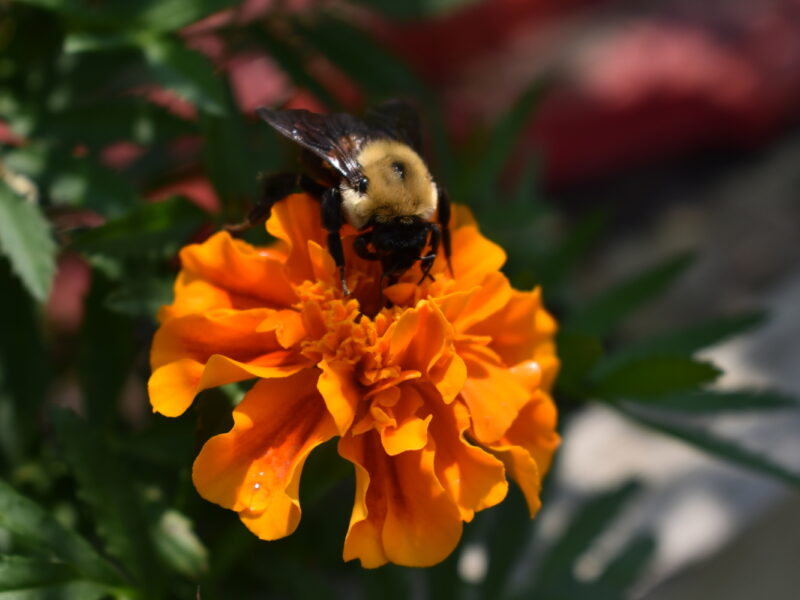

Imagine you’re a honeybee. Maybe half an inch long, living in a commune with 40,000 or so of your family members. Your job is to fly out to work every day and bring home the bacon, er, nectar. You were born with a GPS so precise that you can fly as far as five miles away from your colony and find your way back home before nightfall.
Then suddenly, one day, you can’t. Your GPS shorts out. You leave the hive in the morning, gather nectar from a few flowers, but when it’s time to head back, you have no idea where home is.
This loss of orientation has been one of the main issues plaguing honeybee colonies for the past three decades, ever since neonicotinoids, or neonics, became part of the agricultural landscape.
With a chemical structure closely related to nicotine, neonics are now the single most popular class of insecticide in the country. The National Resource Defense Council explains that they work by binding to insects’ nerve cells, weakening a bug’s immune system, navigation ability, stamina, memory and fertility. “Exposed insects often exhibit uncontrollable shaking and twitching followed by paralysis before eventually dying,” according to the NRDC’s website.
Three of the most common are clothianidin, imidacloprid and thiamethoxam, all of which have been widely used in farm and garden products from companies including Bayer, Ortho and Knockout. And they’re not just limited to agricultural products. Imidacloprid is an active ingredient in Seresto flea and tick collars for dogs, which led to the EPA issuing an order in 2023 that warning labels be placed on the collars.
In farming, neonics are used as seed coating for corn, soybean and oat crops — a method that was initially thought to be less harmful to bees and other wildlife than spraying, but in reality, just makes the entire plant toxic — leaves, stems, pollen, nectar and fruit. It’s also used as a spray on fruit trees, and by some landscaping companies to keep bugs away from lawns and ornamentals.
The chemicals stay active in the soil for years, often contaminating local water supplies. Human exposure to neonics is widespread, and researchers are finding the results of that exposure can range from lower testosterone levels to malformations of the brain and heart in humans and other mammals.
In short, this is not something you want to be eating or having your kids and pets exposed to.
Now finally, after a long battle, New York has implemented a ban on the chemicals with the Birds and Bees Protection Act. Signed into law late last year by Governor Kathy Hochul, the law will phase out almost all neonic usage by 2027.
State Assemblyman Fred Thiele, a member of the state’s environmental and conservation committee and one of the act’s co-sponsors, said that because agriculture and water quality are both “very big issues” in his district, which includes the East End, this has been a hot button for him for a long time.
“Even before looking at the issue from the point of protecting our pollinators, the issue was protecting our water quality,” he said. “When your drinking water comes from your underground aquifer, everything that goes into the ground ultimately ends up in your water supply, and we’ve had numerous instances here on the East End where pesticides and insecticides have had an adverse impact on our water quality. Then the larger issue here is if we have no pollinators, we have no agriculture.”
Thiele, who has been pushing for this legislation for over five years, explained that “it’s kind of an education process in Albany. When people think about agriculture in New York, they think about upstate. They don’t think about Suffolk County, which — because of the East End — ranks as one of the top three counties in the state as far as agriculture goes.”
While the bill went through several iterations before getting enough votes to head to the governor’s desk, Thiele said it remains a win for the environment. “Some concessions were made in the process. It delays some of the implementation, depending on the particular neonics you’re talking about, and we made some modifications to the waiver process in case a farmer can show there’s basically no option other than neonic-coated seeds. It gives farmers enough time to adjust their practices, but I still consider it to be a very strong bill. Over time these neonics are going to be phased out.”
“Most of our economy on the East End depends on the environment. Whether it’s agriculture, or the commercial fishing industry, or second homes, we need clean water for all of that. That’s why people come out here, that’s our attraction,” he said.
While the Birds and Bees Protection Act isn’t perfect, it’s clearly seen as a move in the right direction — and a late-season victory for Thiele, who recently announced he won’t be running for another term.
“This bill did not happen overnight,” he said, noting the slow-motion nature of politics. “But every once in a while you get a victory that keeps you going, and this is one of them.”
This is the first of a two-part series related to the Birds and Bees Protection Act. Next time we’ll look at how some local businesses use alternatives to neonics and other dangerous chemicals.
 More Posts from Lisa Daffy
More Posts from Lisa Daffy